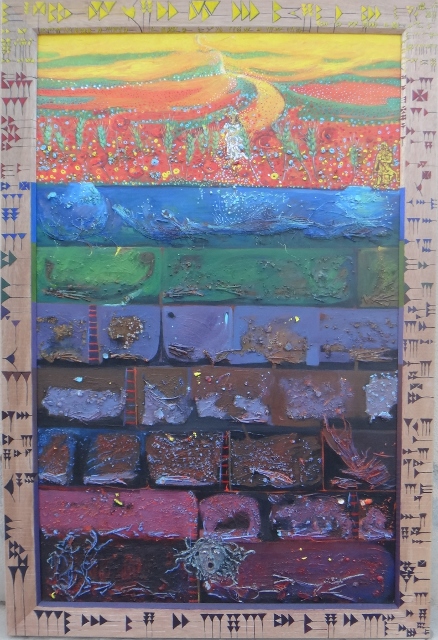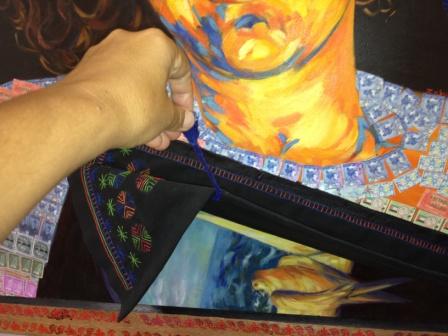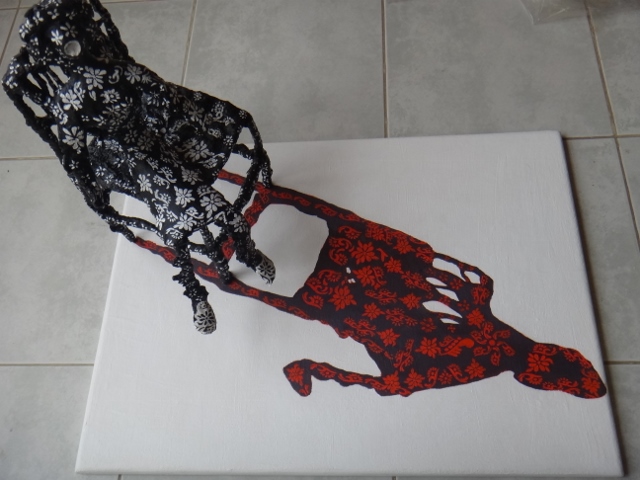Symphony of the Myth of Life & Death.
My turning 40 and the death of my father encouraged me to look inside myself, being like Gilgamesh in a time of searching as he roamed, walking between lands searching for the meaning of life. I am treating my latest project, ‘Zahidah’, as a narrative, an opportunity to communicate how I have transformed over time. I am asking the viewer to associate particular events to a broad conception of events.
On the upper level I am trying to talk about the celebrity of life and death. The red flowers represent the anemone spring flowers. Flowers are the sign of the start of spring in Syria, to be followed with a healthy land full of wheat. Their presence in Spring in Syrian mythology is a sign of a well fertilized soil. At present the Syrian soil is soaking blood and receiving a lot of bodies. The flower is also a symbol of the blood of the dead. The deaths occurring at the moment just as Spring starts are in a way nourishing an already healthy land. According to Syrian mythology, the red anemone flower represents the rebirth of the god Tammuz who dies in Autumn and comes back to life in Spring. He is the son of the mother goddess, Ishtar (Flora, Isis). I represent Ishtar with her snake on the shoulder surrounded with flowers and wheat. On the upper right side I place Gilagmesh next to the eastern hole to the Underworld. He is searching for the meaning of life and death after the death of his friend Ankido, as according to the Epic of Gilgamesh. Dark colours represent the seven underworld levels. I added Medusa in the last level to represent the last level of death. Our Syrian death goddess is called Ereshkigal. I use calm and quiet colours for the underworld to show the beauty of death despite our fear we have of it. Medusa represents that fear. The more underground the level, the warmer the colours become. I painted the upper two levels with blue, then green. As the levels go down and the environment gets quieter, I use more relaxing, warm colours.
According to mythology on the way to the underground there are two big holes. One is to the east, while the other is in the west. Those who are meant to die will go first through one of these holes, and face a river to get under. As the deceased moves to a new level, his or her powers reduce at each level passed through.
I also consider the painting in a more personal way. I put Ishtar opposite Medusa to represent myself in moods of happiness and anger. The underworld could be also me trying to dig deep inside myself. I have also tried to represent my poetic thoughts of life and death through Syrian mythology, and my poetic thoughts of survival for what is happening in my land Syria. I experienced great emotional feeling when I was doing this painting. I didn’t want to finish!
The writing around the frame is examples of ancient Ugaritic letters from tablets of the ancient language first found at Ras Al Shamra (Ugarit, dated around 3500 BC), near my family’s town. I transliterated some Arabic letters to Ugaritic using them in the painting. It is fascinating that Arabic possesses the sounds of Ugaritic! The Epic Of Gilgamesh was of course first written in an earlier cuneiform Sumerian language.
“Said the tavern-keeper to him, to Gilgamesh:
‘O Gilgamesh, where are you wondering?
‘The life that you seek you never will find:
When the gods created mankind,
Death they dispensed to mankind,
Life they kept for themselves,
‘But you, Gilgamesh, let your belly be full,
Enjoy yourself always by day and by night!
Make merry each day,
dance and play day and night!
‘Let your clothes be clean,
Let your head be washed, may you bathe in water!
Gaze on the child who holds your hand,
Let your wife enjoy your repeated embrace!
‘For such is the destiny (of mortal men,)
That the one who lives……………’













